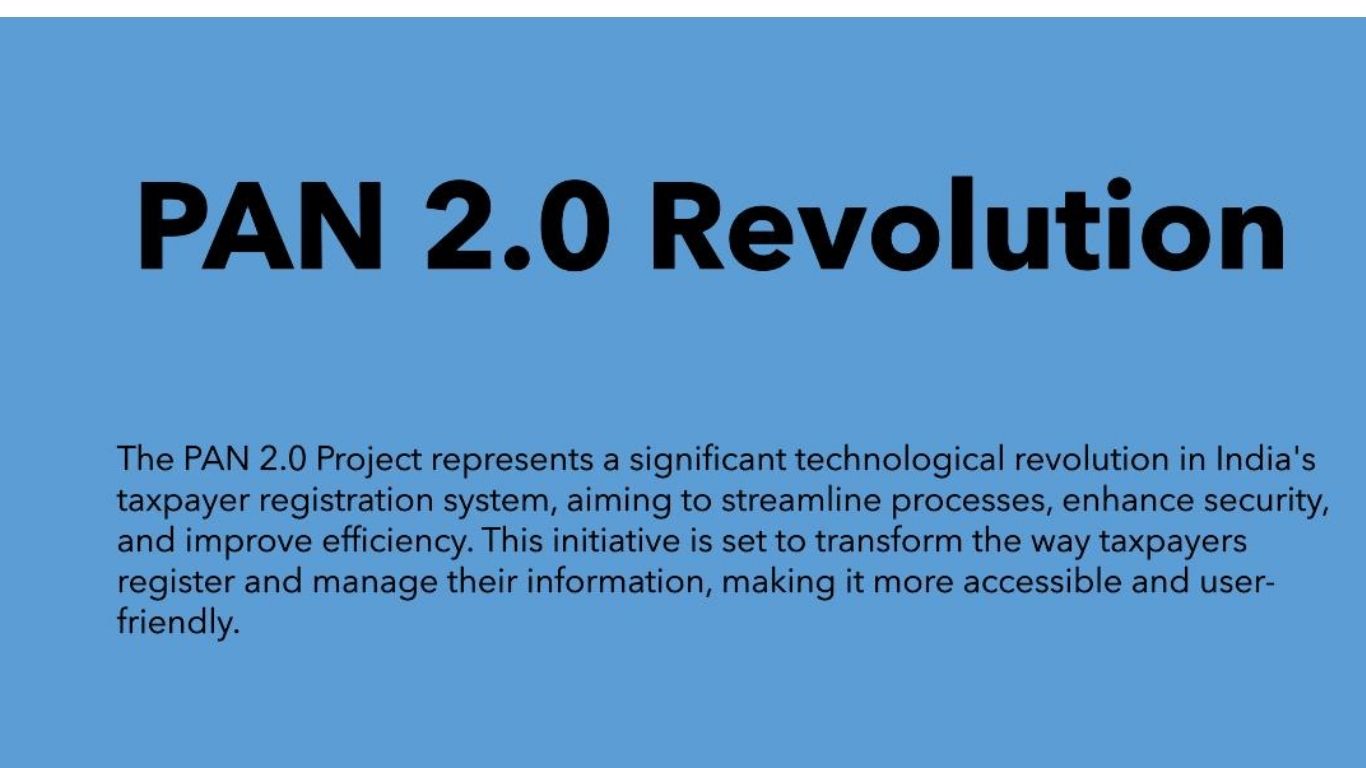PAN 2.0 Project: A Technological Revolution in India’s Taxpayer Registration System
The Union Cabinet has recently approved the PAN 2.0 project, an ambitious initiative by the Income Tax Department of India. This project, with an investment of ₹1,435 crore, aims to modernize taxpayer registration services and transition towards a common business identifier. By leveraging cutting-edge technology, PAN 2.0 promises to enhance security, improve user experience, and streamline tax compliance, benefitting both the taxpayers and the government.
What Is PAN 2.0?
PAN 2.0 refers to an upgraded version of the Permanent Account Number (PAN) system, designed to modernize and simplify the process of taxpayer registration. The goal is to make the tax administration more efficient and transparent by incorporating advanced technology and security features. PAN 2.0 will serve as a more reliable and integrated tool for tracking and managing taxpayers, both individuals and businesses.
The Role of the Income Tax Department in PAN 2.0
The Income Tax Department has taken the lead in driving this initiative, with a clear vision to overhaul the existing registration process. Through PAN 2.0, the department will ensure that all taxpayers, including businesses, are accurately identified using a unified system. This will simplify compliance processes and reduce the administrative workload of both the taxpayers and the authorities.
Key Features of PAN 2.0
PAN 2.0 comes with several transformative features that set it apart from the current system. Let’s break down the most important aspects of this upgrade:
Technology-Driven Transformation
The incorporation of advanced technology in PAN 2.0 will modernize taxpayer registration services. This will allow the system to operate with greater accuracy and efficiency, ensuring faster processing of applications and minimizing human errors. Additionally, automation will streamline operations, reducing the time and effort spent on administrative tasks.
Establishing a Common Business Identifier
One of the standout features of PAN 2.0 is the establishment of a single, unified business identifier. This common identifier will apply to all businesses, irrespective of size or industry, making it easier for the tax authorities to track business transactions and tax liabilities. It will also simplify tax compliance for businesses by consolidating multiple identification numbers into one, reducing the complexity of the tax filing process.
Enhanced Security Measures
Security is a critical aspect of any tax-related system, and PAN 2.0 will introduce enhanced measures to safeguard taxpayer data. The project will incorporate advanced encryption techniques and secure data storage practices to prevent data breaches and fraud. These measures will provide taxpayers with the confidence that their personal and financial information is protected.
Improved User Experience
PAN 2.0 aims to create a more user-friendly interface for taxpayers. This includes simplified online registration processes, better accessibility, and faster service delivery. By improving the overall user experience, the Income Tax Department hopes to make taxpayer interactions with the system smoother and more convenient.
Cost of the PAN 2.0 Project
The PAN 2.0 project is estimated to cost ₹1,435 crore, a significant investment that reflects the scale of the transformation. While this upfront cost is considerable, the long-term benefits are expected to outweigh the expenditure. The project will help reduce inefficiencies, improve compliance rates, and make tax administration more transparent.
Benefits for Taxpayers
PAN 2.0 offers several benefits for individual taxpayers, including:
- Faster registration: With a streamlined process, registering for a PAN will be quicker and easier.
- Simplified compliance: The common business identifier will reduce the complexity of managing multiple identification numbers for businesses.
- Enhanced privacy: Increased security will ensure that taxpayer data is less vulnerable to fraud and misuse.
Benefits for the Government
For the government, PAN 2.0 promises numerous advantages, such as:
- Efficient tax collection: A more streamlined and accurate system will make it easier to track and collect taxes.
- Improved transparency: The upgraded system will allow for more detailed reporting and auditing, reducing the scope for tax evasion.
- Reduced administrative workload: The automation and integration of systems will reduce the burden on government officials, allowing them to focus on more strategic tasks.
Challenges in Implementing PAN 2.0
While PAN 2.0 offers great potential, the implementation process may face several challenges:
- Technology integration: Ensuring that the new system integrates smoothly with existing infrastructure will require careful planning and execution.
- Training requirements: Taxpayers and government officials will need training to navigate the new system effectively.
- Data migration: Migrating data from the old system to PAN 2.0 could pose logistical challenges, especially when dealing with a large volume of records.
Impact on Tax Administration
PAN 2.0 will have a significant impact on India’s overall tax administration. By creating a more efficient and transparent system, the government will be better equipped to enforce tax compliance and improve revenue collection. The automation of processes will also allow for quicker tax processing, benefiting both taxpayers and government officials alike.
Global Perspective: PAN 2.0 in the Context of Global Tax Systems
Many countries have embraced similar projects to modernize their tax systems. For example, nations like the United States and the United Kingdom have already implemented systems that centralize taxpayer identification and business records. PAN 2.0 aligns India with these global trends, positioning the country as a leader in tax system modernization.
Future of Taxpayer Registration in India
The implementation of PAN 2.0 marks the beginning of a new era in taxpayer registration. As the system evolves, it is expected to bring further improvements, such as the integration of artificial intelligence (AI) and machine learning (ML) for predictive analytics in tax collection and fraud detection.
Conclusion
The PAN 2.0 project represents a major leap forward for India’s tax administration, aiming to simplify taxpayer registration, improve efficiency, and enhance security. This modernization effort will not only streamline processes but also create a more transparent and user-friendly system for taxpayers. With the approval of the ₹1,435 crore budget, the future of India’s tax system looks brighter than ever.
FAQs
- What is PAN 2.0?
PAN 2.0 is an upgraded version of the Permanent Account Number system aimed at modernizing taxpayer registration and improving tax compliance in India. - How will PAN 2.0 benefit taxpayers?
PAN 2.0 will simplify the registration process, enhance security, and reduce the complexity of managing multiple business identifiers for businesses. - What is a common business identifier?
A common business identifier is a single, unified ID that will apply to all businesses, making tax compliance easier and more efficient. - How much will PAN 2.0 cost?
The PAN 2.0 project has been approved at a cost of ₹1,435 crore, which will be invested in upgrading technology and infrastructure. - How will PAN 2.0 impact tax administration?
PAN 2.0 will streamline tax processes, improve transparency, and enhance the government’s ability to track and collect taxes efficiently.















